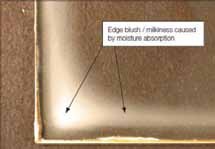Selecting the appropriate impact resistant glass make-up is an important part of your window and door selection.
Step 1: Select between laminated glass or insulated laminated glass.
Laminated Hurricane Impact Resistant Glass is comprised of two sheets of glass bonded together with a protective interlayer. Laminated glass is the primary hurricane barrier used in impact resistant windows. Laminated glass is also used in the windshields of cars. Hurricane impact resistant products use a thicker sandwich of glass and special film interlayer to make the glass unit stronger. Laminated glass also eliminates 99% of UV rays, reduces noise transmission, provides enhanced security protection for your home, and reduces the air conditioning and heating portion of your energy bill.
Insulated Laminated Glass adds an extra single pane of glass to the laminated glass unit with a hermetically sealed air space (or gas filled space) in between. This glass is generally more expensive but offers enhanced energy performance. The air or gas filled space serves as an insulator between the temperature difference that exists between the inside and the outside. Although it is more useful in colder climates, it does improve the performance of LoE coatings and in some cases architects or local building departments are requiring its use.
Step 2: Decide whether to use a LoE coating or glass tints.
Tinted Glass – CGI offers a variety of glass tints. Tinted glass is likely the most cost effective solution combining cost reductions with energy efficiency. Tinted glass absorbs incoming solar radiation through the glass thereby reducing the heat and light transfer into a room. Gray and bronze tinted windows—the most common—reduce the penetration of both light and heat into buildings in equal amounts. Blue and green tinted windows offer greater penetration of visible light and slightly reduced heat transfer compared with other colors of tinted glass. Green or blue colored glass tends to paint your room in the same color. Gray and bronze tints tend to be more color neutral on the interiors. Clear glass is also available, although without special coatings or tints heat transfer is not minimized.
LoE Glass– LoE coatings are applied to the internal glass surface to separate heat energy (long wave) and light energy (short wave). The heat energy (long wave) is reflected back to the heat source and the short wave can pass through the coating. CGI offers high performance coatings on its insulated laminated products.
With all of these options of tints, LoE and Insulated Glass, how do I decide?
In warm tropical climates if you are cost conscious, avoid insulated glass if not required by codes. Suggest tinted glass or clear glass with LoE. If you want the best energy performance, consider insulated laminated glass with a LoE coating. Also, discuss with your dealer to ensure that you are in compliance with building code requirements.

